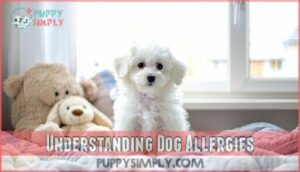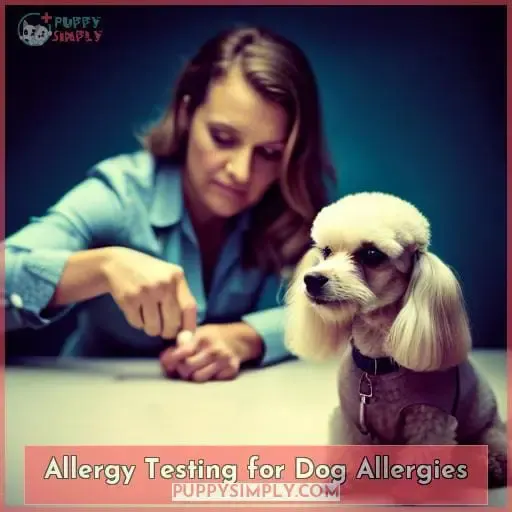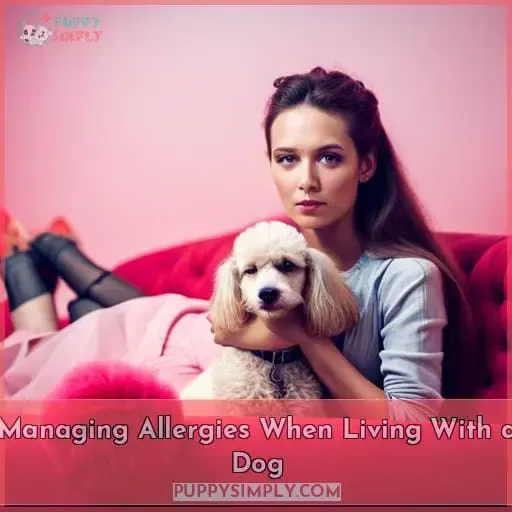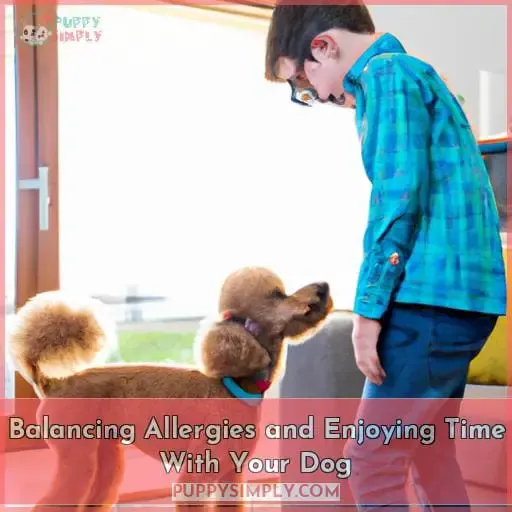This site is supported by our readers. We may earn a commission, at no cost to you, if you purchase through links.
 Imagine finding a furry companion that brings joy and doesn’t trigger your allergies.
Imagine finding a furry companion that brings joy and doesn’t trigger your allergies.
If you’re searching for an allergy-friendly dog breed, poodles might be the perfect choice for you. With their unique coat characteristics and low allergen levels, poodles are often considered hypoallergenic.
In this article, we’ll provide tips for families with allergies who are considering adding a poodle to their home. Discover how to manage allergies while enjoying the company of these intelligent and loving dogs.
Table Of Contents
- Key Takeaways
- Poodles: the Ideal Hypoallergenic Dog Breed
- Other Hypoallergenic Dog Breeds to Consider
- Understanding Dog Allergies
- Allergy Testing for Dog Allergies
- Tips for Choosing a Dog When You Have Allergies
- Managing Allergies When Living With a Dog
- Balancing Allergies and Enjoying Time With Your Dog
- Seeking Professional Help for Allergies
- Frequently Asked Questions (FAQs)
- What are the pros and cons of getting a puppy versus an adult poodle if you have allergies?
- How often should you bathe a poodle if you have dog allergies?
- What kinds of allergy medications work best for dog allergies?
- How do you find a responsible poodle breeder who focuses on health and temperament?
- What should you do if your allergies get worse after bringing your poodle home?
- Conclusion
Key Takeaways
- Poodles are hypoallergenic due to their curly and dense coat, low shedding, and production of fewer allergens than other breeds.
- Poodles have low levels of allergens such as dander, saliva, and hair compared to most other dog breeds.
- Regular grooming is important for poodles, including brushing, bathing, nail trimming, ear cleaning, and teeth brushing.
- Families with allergies can also consider other hypoallergenic dog breeds such as Bichon Frise, Italian Greyhound, Portuguese Water Dog, and Chihuahua.
Poodles: the Ideal Hypoallergenic Dog Breed
When it comes to hypoallergenic dog breeds, poodles are often considered the ideal choice.
Poodles have a unique coat that consists of tight curls, which helps to minimize shedding and dander.
Additionally, poodles’ low allergen levels make them less likely to trigger allergic reactions in sensitive individuals.
However, it’s important to note that poodles require regular grooming to keep their coats healthy and free from matting.
Poodle’s Coat Characteristics
If you’re considering a poodle as a hypoallergenic dog breed, understanding their coat characteristics will be crucial in making an informed decision.
- Curly and Dense: Poodles have curly and dense coats that trap dander close to the skin, reducing its release into the environment.
- Low Shedding: Due to their unique coat structure, poodles shed very little hair compared to other breeds.
- Non-Allergenic: While no dog is completely allergen-free, poodles are often considered hypoallergenic because they produce fewer allergens than dogs with different types of coats.
- Wool-like Texture: The texture of a poodle’s coat can resemble wool rather than traditional fur found on other breeds.
Understanding these characteristics can help allergy-friendly families determine if a poodle would be suitable for them due to its low shedding and non-allergenic qualities.
Poodles’ Low Allergen Levels
When it comes to hypoallergenic dog breeds, poodles stand out due to their low allergen levels and are ideal for allergy-friendly families.
Research shows poodles produce minimal dander, saliva, and hair allergens compared to other breeds.
Studies measuring the allergen Can f 1, a major dog allergy trigger, find much lower levels in poodles than most dogs, even some breeds wrongly marketed as hypoallergenic.
For families seeking an allergy-friendly pet, poodles are a top choice, especially paired with allergy treatments and household changes like frequent cleaning to further reduce allergen exposure.
Grooming Requirements for Poodles
You’ll want to keep up with professional grooming for your poodle on account of their continuously growing coat.
- Regular brushing
- Occasional bathing
- Nail trimming
- Ear cleaning
- Teeth brushing
Keeping up with these grooming tasks for your poodle will help minimize shedding and allergens.
Other Hypoallergenic Dog Breeds to Consider
If you’re considering a hypoallergenic dog breed other than a poodle, there are several options to explore.
- The Bichon Frise is a calm and trainable small dog with low activity levels.
- The Italian Greyhound is elegant and peaceful, requiring minimal grooming.
- Another option is the Portuguese Water Dog, known for its low shedding and single coat.
- Finally, the Chihuahua has a tiny frame and single coat with various colors available.
Bichon Frise
Continuing our exploration of hypoallergenic dog breeds, let’s now consider the Bichon Frise, a delightful option for allergy-friendly families.
The Bichon Frise is known for its low shedding coat and friendly temperament. This small breed requires regular grooming to maintain their hypoallergenic qualities. They’re relatively low in exercise needs but enjoy daily walks and playtime. With proper care and attention, the Bichon Frise can be a wonderful addition to families with allergies.
| Breed: | Bichon Frise |
|---|---|
| Shedding: | Low shedding |
| Temperament: | Friendly |
| Hypoallergenic: | Yes |
| Grooming Needs: | Moderate – frequent brushing required |
Italian Greyhound
With the Italian Greyhound breed, you’ll find little shedding thanks to the short, fine coat protecting a small, lean physique while still promising a peaceful, quiet companion animal.
Italian Greyhounds have low energy levels and require minimal grooming. They’re known for their long lifespan and can be easily trained due to their intelligence.
As hypoallergenic dogs, they make an excellent choice for allergy-friendly families who want a low-shedding pet that doesn’t require excessive vacuuming or grooming maintenance.
Portuguese Water Dog
If you frequently experience allergies and are looking for a hypoallergenic dog breed to consider, the Portuguese Water Dog may be a great option for you.
With their low shedding coat and single coat structure, these dogs produce fewer allergens that can trigger allergy symptoms.
They’ve an energetic level which makes them suitable for active families who enjoy outdoor activities.
However, it’s important to note that grooming needs are higher compared to other hypoallergenic breeds due to their curly hair.
Chihuahua
When considering other hypoallergenic breeds, you’re looking at the Chihuahua with its single coat and tiny frame.
This breed is intelligent, alert, and long-lived. Chihuahuas come in a wide variety of colors, markings, and coat types.
They’re energetic dogs that require plenty of exercise to stay healthy. Their small size makes them suitable for apartment living as well.
Grooming needs are minimal for this low-shedding breed.
Understanding Dog Allergies
Many people assume hypoallergenic dogs like Poodles won’t cause allergies. However, all dogs produce allergens that can trigger symptoms in sensitive individuals.
To better understand if a Poodle is right for your family, let’s examine what exactly causes dog allergies and how they manifest.
Causes of Allergies to Dogs
Allergy symptoms arise from exposure to pet dander present in a dog’s skin flakes (dander), saliva or hair. These substances often combine with other irritants found in urine and feces, exacerbating allergic reactions caused by pets’ protein-rich molecules known as Can F-1 and Can F-5, generated by both male and neutered ones alike.
Even though some breeds are labeled ‘hypo-allergenic,’ they still produce ample amounts which become airborne during self-grooming sessions if not managed through regular grooming practices like bathing frequently but without excessive stripping off valuable oils needed within fur strands, promoting overall healthy coats while lessening chances triggering sensitivities, further aided via specialized treatments like allergy immunotherapy to enhance tolerance levels.
Common Allergens Found in Dogs
Dog allergens are commonly found in dander, saliva, and hair.
Dander consists of microscopic skin flakes shed by dogs that contain proteins triggering allergic reactions.
Saliva and urine also contain allergy-provoking proteins.
When grooming, dogs spread these allergens over their fur.
Air circulation then disperses the allergens, allowing them to be inhaled or come into contact with individuals.
Monitoring environments for these allergens assists allergy sufferers in managing symptoms.
How Allergies Manifest in Individuals
Tips for Allergy-Friendly Families:
When you’re around dogs, you may experience symptoms like sneezing, itchy eyes, runny nose, coughing or a skin rash.
The specific allergens can vary from person to person but often include dander (tiny bits of shed skin), saliva and hair. Understanding how allergies manifest in individuals is crucial for managing your allergy symptoms and creating an allergy-friendly environment for your family.
Allergy Testing for Dog Allergies
Different allergy tests can help determine exactly what you’re allergic to when it comes to dogs.
Getting tested allows you to make informed decisions when choosing a hypoallergenic breed that will work for your family.
Understanding your results enables you to take measures to manage symptoms and improve your quality of life with a furry friend.
Different Types of Allergy Tests
When considering if you or a family member has allergies to dogs, it’s important to explore the different types of allergy tests available.
Skin prick tests and blood tests like RAST look for IgE antibodies.
Intradermal testing injects allergens below skin.
Patch testing places allergens on skin.
Knowing the options empowers you to get the right diagnosis.
Benefits of Allergy Testing
You’ll gain valuable insight into which allergens trigger your symptoms so you can make informed decisions about managing your dog allergies.
Allergy testing can help eliminate false positives, precisely identify triggers, and determine which proteins provoke reactions.
This allows you to take targeted steps to reduce symptoms, improve quality of life, and avoid costly treatments down the line.
Knowing exactly what you’re allergic to empowers you to control exposures and establish boundaries.
How to Interpret Allergy Test Results
By understanding your allergy test results, you’re determining which allergens provoke symptoms so appropriate care can be taken when interacting with dogs.
Allergy tests identify specific allergen types like pet dander and saliva that elicit skin reactions.
Knowing your sensitivities guides decisions on breeds, allergy shots for tolerance, or avoiding contact with provoking allergens altogether for symptom relief.
Tips for Choosing a Dog When You Have Allergies
When bringing a dog into an allergy-prone household, first consider your family’s lifestyle and activity level to choose a suitable breed.
Research breeds commonly labeled hypoallergenic and meet with individual dogs prior to adoption to test your reaction.
Interacting with potential pets beforehand allows families to make an informed decision when selecting the right dog for their needs.
Consideration of Lifestyle and Activity Level
To find the perfect hypoallergenic dog breed that fits your allergies and lifestyle, it’s important to consider factors such as your activity level and the type of environment you can provide for the dog.
- Low maintenance breeds like Bichon Frise may match well if you lead a busy lifestyle.
- Small size adaptable breeds like Chihuahuas can thrive in apartments.
- Trainable, good with kids breeds like Poodles make great family dogs.
Researching Hypoallergenic Breeds
When researching hypoallergenic breeds, consider the specific needs and characteristics that will best suit your allergy-friendly family.
Carefully research breeds often labeled hypoallergenic, like Poodles, understanding no dog is truly allergy-free.
Before adopting, spend time interacting with potential breeds to gauge allergy symptoms.
Creating pet-free zones, practicing good hygiene, allergy-proofing your home, and exploring allergen immunotherapy can help manage allergies while living with a dog.
Meeting and Interacting With the Dog Before Adoption
One best practice is to spend 15-20 minutes with your chosen breed in person before bringing them home to see what level of allergic reaction, if any, they produce for you.
- Observe the dog’s play style and interactions with people or other pets during this time.
- Make multiple visits over a few weeks if possible, to determine consistency of reactions.
- Have all family members interact with the dog for at least 15-20 minutes during visits.
Managing Allergies When Living With a Dog
To manage allergies when living with a dog,
- Regular grooming and bathing is essential to reduce dander and allergens on your pet’s coat.
- Cleaning and allergen-proofing your home can help minimize exposure to allergens by regularly vacuuming, using air filters, and keeping your pet out of certain areas like bedrooms.
- If necessary, medications or allergy shots prescribed by a doctor can provide relief from symptoms associated with dog allergies.
Regular Grooming and Bathing
When living with a dog and managing allergies, regular grooming and bathing are essential for allergy-friendly families.
| Task | Frequency | Benefits | Risks |
|---|---|---|---|
| Bathing | Every 2-4 weeks | Removes allergens | Overbathing strips oils |
| Brushing | Daily | Distributes oils | None |
| Dry shampoo | As needed | Absorbs oils | None |
Cleaning and Allergen-proofing the Home
So you’ll want to keep surfaces clean by:
- Vacuuming frequently
- Washing bedding weekly
- Dusting regularly
To limit exposure to allergens in your home environment.
- Vacuum carpets and upholstery daily.
- Wash bedding and pet items weekly in hot water.
- Run an air purifier in main living areas.
- Keep your pet out of the bedroom.
- Consider allergy immunotherapy shots.
Using Medications or Allergy Shots as Needed
As allergy symptoms flare up, you’ll need to:
- Take any prescribed allergy medications.
- Get allergy shots from your doctor to build tolerance against the allergens.
These immunotherapy shots can provide long-term efficacy, but discuss potential side effects and risks with your doctor. Though costly, they may provide liberation from symptoms without medication side effects.
Balancing Allergies and Enjoying Time With Your Dog
You can take some simple steps to allow family members with allergies to still enjoy time with your poodle.
Try designating certain rooms or furniture as pet-free zones.
Practice good hygiene like handwashing after touching the dog.
Carefully monitor allergy symptoms, managing them with medication if necessary.
Taking these basic precautions can help balance an allergy sufferer’s health with quality time for the whole family to bond with your poodle.
Establishing Pet-free Zones in the Home
To create a more allergy-friendly environment in your home, establish designated areas where your dog isn’t allowed.
This will help minimize exposure to allergens and provide relief for allergy sufferers.
Consider setting up pet-free rooms such as the bedroom, bathroom, kitchen, or any other area where you spend a significant amount of time.
By creating these designated spaces, you can strike a balance between enjoying time with your dog while also prioritizing the well-being of everyone in the household.
Practicing Good Hygiene After Interacting With the Dog
You’ll want to wash your hands thoroughly after petting your dog to prevent allergens from remaining on the surface of your skin and triggering allergy symptoms.
It’s also recommended to shower and change clothes if you’ve had significant contact with your dog. Vacuuming carpets regularly is essential as well, as it helps remove any dander or hair that may have collected in the environment.
| Hygiene Practices |
|---|
| Wash Hands |
| Use Hand Sanitizer |
| Shower |
| Change Clothes |
Monitoring and Managing Allergy Symptoms
Five key ways you’re managing your allergy symptoms while bonding with your poodle include:
- Establishing pet-free zones
- Practicing good hygiene
- Monitoring symptoms daily
- Adjusting medications as needed
- Seeing an allergist regularly.
Some tips for monitoring and managing allergy symptoms include:
- Keeping a symptom journal to track the severity of reactions
- Identifying triggers that worsen allergies such as pollen or dust mites
- Considering antihistamines to alleviate symptoms
It’s important to be aware of any potential side effects from medication use and consult with a healthcare professional for guidance.
Seeking Professional Help for Allergies
If you’re struggling with allergies and considering getting a poodle as a hypoallergenic pet, it’s important to seek professional help from an allergist or immunologist.
These specialists can provide expert guidance on managing your allergies and determining if owning a poodle is the right choice for you. Additionally, they can explore additional treatment options such as allergy shots or medications to help alleviate symptoms and improve your quality of life.
Consulting With an Allergist or Immunologist
If you’re experiencing dog allergies and seeking professional help, it’s important to consult with an allergist or immunologist who specializes in allergy management.
An allergist is a medical doctor who diagnoses and treats allergies, while an immunologist focuses on the immune system and its response to allergens.
These specialists can conduct tests to determine your specific allergy triggers and provide personalized treatment plans.
Seeking their expertise can greatly benefit individuals with dog allergies by helping them manage their symptoms effectively.
Exploring Additional Treatment Options
Consider consulting with an allergist or immunologist for exploring additional treatment options like allergy immunotherapy shots. These injections help desensitize your body to the allergens, building tolerance over time.
Discuss medications, supplements, or other therapies that may provide allergy relief so you can enjoy life with your Poodle while managing symptoms.
Frequently Asked Questions (FAQs)
What are the pros and cons of getting a puppy versus an adult poodle if you have allergies?
A puppy allows early exposure to develop tolerance, but an adult poodle lets you immediately assess allergy symptoms. Carefully interact with individual dogs first, since no breed is truly hypoallergenic.
How often should you bathe a poodle if you have dog allergies?
You should bathe your poodle once every 2-4 weeks with a mild shampoo.
Frequent bathing strips oils from their coat, worsening shedding and dander production.
What kinds of allergy medications work best for dog allergies?
You should talk to your doctor about allergy medication options that are right for you.
Finding the most effective treatment requires an individualized approach based on the severity of your symptoms and your medical history.
How do you find a responsible poodle breeder who focuses on health and temperament?
To find a responsible poodle breeder focused on health and temperament, conduct thorough research.
- Look for breeders who prioritize genetic testing, socialization, and providing a clean environment.
- Ask for references and visit the facility to assess their practices firsthand.
What should you do if your allergies get worse after bringing your poodle home?
Unfortunately, allergies can worsen even with hypoallergenic breeds. See an allergist to explore treatment options.
Meanwhile,
- Bathe your poodle frequently
- Keep them out of bedrooms
- Vacuum diligently
- Consider allergy medication
This will help reduce symptoms while determining next steps.
Conclusion
To conclude, poodles are an ideal choice for allergy-friendly families.
Their unique coat characteristics and low allergen levels make them hypoallergenic and less likely to trigger allergies.
By understanding dog allergies, conducting allergy testing, and following tips for choosing and managing allergies when living with a dog, families can enjoy the companionship of a poodle without suffering from allergic reactions.
Remember to seek professional help from an allergist or immunologist for additional guidance and treatment options.
With poodles, you can have a furry companion that brings joy without the discomfort of allergies.














